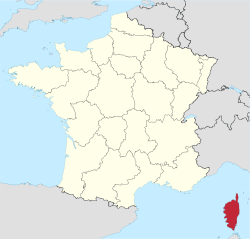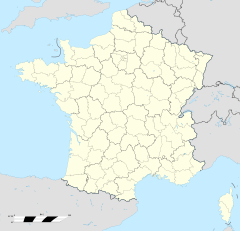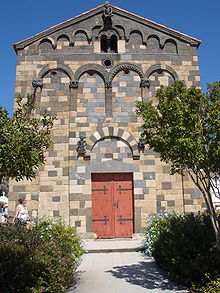- Corsica
-
"Corse" redirects here. For other uses, see Corse (disambiguation) and Corsica (disambiguation).
Corsica
Corse— Region of France — 
Flag
LogoCountry  France
FrancePrefecture Ajaccio Departments Government - President Paul Giacobbi (PRG) Area - Total 8,680 km2 (3,351.4 sq mi) Population (2008-01-01) - Total 302,000 - Density 34.8/km2 (90.1/sq mi) Time zone CET (UTC+1) - Summer (DST) CEST (UTC+2) GDP/ Nominal € 7 billion (2006)[1] GDP per capita € 20,300 (2006)[1] NUTS Region FR8 Website corse.fr Corsica (
 /ˈkɔːrsɪkə/; French: Corse, IPA: [kɔʁs]; Corsican: Corsica; Italian: Corsica, IPA: [ˈkɔrsika]) an island in the Mediterranean Sea. It is located west of Italy, southeast of the French mainland, and north of the island of Sardinia.
/ˈkɔːrsɪkə/; French: Corse, IPA: [kɔʁs]; Corsican: Corsica; Italian: Corsica, IPA: [ˈkɔrsika]) an island in the Mediterranean Sea. It is located west of Italy, southeast of the French mainland, and north of the island of Sardinia.Corsica is one of the 27 régions of France, although strictly speaking Corsica is designated as a "territorial collectivity" (collectivité territoriale) by law. As a territorial collectivity, it enjoys greater powers than other French régions, but for the most part its status is quite similar. Corsica is referred to as a "région" in common speech, and is almost always listed among the other régions of France. Although the island is separated from the continental mainland by the Ligurian Sea and is closer to Italy than to the French mainland, politically Corsica is part of Metropolitan France.[citation needed] It was once briefly an independent Corsican Republic, until being incorporated into France in 1769. Its culture has French and Italian elements blended into it.
Napoléon Bonaparte was born in Ajaccio, where his ancestral home, Casa Buonaparte, is also located. Corsica is also the birthplace of the singers Tino Rossi and Alizée.
Contents
History
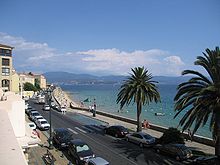 Seafront boulevard in Ajaccio, the island's capital and Napoleon I's birthplace
Seafront boulevard in Ajaccio, the island's capital and Napoleon I's birthplace
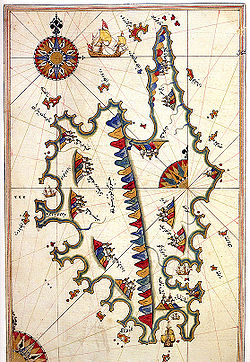 Map of Corsica by Piri Reis.
Map of Corsica by Piri Reis.
Corsica has been occupied continuously since the Mesolithic era. It acquired an indigenous population that was influential in the Mediterranean during its long prehistory. After a brief occupation by the Carthaginians, colonization by the ancient Greeks and an only slightly longer occupation by the Etruscans it was preempted by the Roman Republic and became with Sardinia a province of the Roman Empire. In the 5th century, the Roman Empire collapsed and the island was invaded by the Vandals, the Visigoths, the Saracens and the Lombards. Pepin the Short, king of the Franks and Charlemagne's father, expelled the invaders and granted Corsica to pope Stephen II through the exarchate of Ravenna (756), which was the starting point of the temporal power of the papacy.
The Genoese took possession of the island in 1347, and governed it until 1729 – interrupted only by a brief occupation by forces of a Franco-Ottoman alliance in the Invasion of Corsica (1553)[citation needed].
In Corsica, vendetta was a social code that required Corsicans to kill anyone who wronged the family honor. Between 1821 and 1852, no fewer than 4,300 murders were perpetrated in Corsica.[2]
Independent Corsica
In 1729 the Corsican Revolution for independence began. After 26 years of struggle the independent Corsican Republic was formed in 1755 under the leadership of Pasquale Paoli and remained sovereign until 1769 when it was conquered by France. The first Corsican Constitution was written in Italian (the language of culture in Corsica until the end of the 19th century) by Paoli. He proclaimed that Italian was the official language of Corsica.
The Corsican Republic was unable to eject the Genoese from the major coastal cities. Following French losses in the Seven Years War, Corsica was purchased by France from the Republic of Genoa in 1764. After an announcement and brief war in 1768–69 Corsican resistance was largely ended at the Battle of Ponte Novu. Despite triggering the Corsican Crisis in Britain, whose government gave secret aid, no foreign military support came for the Corsicans. Corsica was incorporated into France in 1770, marking the end of Corsican sovereignty. However, nationalist feelings still ran high.
Following the outbreak of the French Revolution in 1789, Pasquale Paoli was able to return to Corsica from exile in Britain. In 1794 he invited British forces under Lord Hood to intervene to free Corsica from French rule. Anglo-Corsican forces drove the French from the island and established an Anglo-Corsican Kingdom. Following Spain's entry into the war the British decided to withdraw from Corsica in 1796. Corsica then returned to French rule.
In 1814 near the end of the Napoleonic Wars the island was briefly occupied again by British troops. The Treaty of Bastia gave the British crown sovereignty over the island, but it was later repudiated by Lord Castelreagh who insisted that the island should be returned to a restored French monarchy.
Modern Corsica
After the collapse of France to the German Wehrmacht in 1940, it came under the rule of the Vichy French regime, which was collaborating with the Nazis. Prior to its use as an aircraft base to attack German occupied Italy, it was liberated by Italian and Free French Forces shortly after the Italian armistice in 1943.
During World War II, the island was nicknamed "USS Corsica", as the United States military established 17 airfields on Corsica for American tactical bomber groups attacking targets in Italy. One of the pilots stationed there was Joseph Heller, who would use his wartime experience in the creation of his novel Catch-22.
During the May 1958 crisis, French paratroopers from the Algerian corps landed on Corsica on May 24, taking the French island in a bloodless action called "Operation Corse".[3]
Geography
 The Bay of Calvi: Corsica is the most mountainous Mediterranean island.
The Bay of Calvi: Corsica is the most mountainous Mediterranean island.
Corsica was formed as an island through volcanic explosions. It is known as the most mountainous island in the Mediterranean. Corsica is 183 kilometres (114 mi) long at longest, 83 kilometres (52 mi) wide at widest, has 1,000 kilometres (620 mi) of coastline, more than 200 beaches, and is very mountainous, with Monte Cinto as the highest peak at 2,706 metres (8,878 ft) and 20 other summits of more than 2,000 metres (6,600 ft). Mountains comprise two-thirds of the island, forming a single chain. Forest comprises 20% of the island.
Approximately 3,500 km2 (1,400 sq mi) of the total surface area of 8,680 km2 (3,350 sq mi) is dedicated to nature reserves (Parc Naturel Régional de Corse), mainly in the interior.[4] Corsica contains the GR20, one of Europe's most notable hiking trails.
The island is 90 kilometres (56 mi) from Tuscany in Italy and 170 kilometres (110 mi) from the Côte d'Azur in France. It is separated from Sardinia to the south by the Strait of Bonifacio, a minimum of 11 kilometres (6.8 mi) wide.[4]
Major communities
Main articles: Communes of the Haute-Corse department and Communes of the Corse-du-Sud departmentIn 2005 the population of Corsica was settled in approximately 360 communities.[5]
Climate
Climate data for Ajaccio, largest city and capital of Corsica Month Jan Feb Mar Apr May Jun Jul Aug Sep Oct Nov Dec Year Average high °C (°F) 13.3
(55.9)13.7
(56.7)15.0
(59.0)17.4
(63.3)20.9
(69.6)24.5
(76.1)27.6
(81.7)27.7
(81.9)25.4
(77.7)22.0
(71.6)17.5
(63.5)14.4
(57.9)19.95 Daily mean °C (°F) 8.6
(47.5)9.0
(48.2)10.1
(50.2)12.3
(54.1)15.7
(60.3)19.1
(66.4)21.9
(71.4)22.1
(71.8)19.9
(67.8)16.7
(62.1)12.6
(54.7)9.6
(49.3)14.80 Average low °C (°F) 3.9
(39.0)4.3
(39.7)5.3
(41.5)7.3
(45.1)10.6
(51.1)13.8
(56.8)16.2
(61.2)16.5
(61.7)14.4
(57.9)11.4
(52.5)7.7
(45.9)4.8
(40.6)9.68 Precipitation mm (inches) 73.8
(2.906)69.7
(2.744)58.1
(2.287)52.0
(2.047)40.2
(1.583)19.0
(0.748)11.0
(0.433)19.9
(0.783)43.6
(1.717)87.0
(3.425)95.9
(3.776)75.5
(2.972)645.7
(25.421)Avg. precipitation days (≥ 1 mm) 8.9 8.7 8.3 7.2 5.7 2.8 1.3 2.4 4.3 7.3 8.6 9.1 74.6 Sunshine hours 133.3 145.0 189.1 225.0 282.1 321.0 365.8 331.7 264.0 210.8 150.0 127.1 2,744.9 Source: Hong Kong Observatory[6] Ecology
Corsica Native name: Corsica
Nickname: L’Île de Beauté
The Isle of Beauty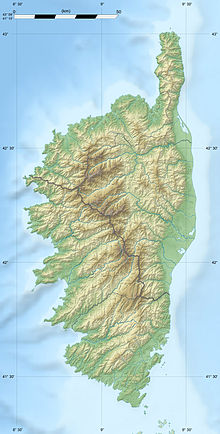
Topography of CorsicaGeography Location Mediterranean Sea Area 8,680 km2 (3,351 sq mi) Length 184 km (114.3 mi) Width 83 km (51.6 mi) Coastline 1,000 km (600 mi) Highest elevation 2,706 m (8,878 ft) Highest point Monte Cinto Country FranceRégion Corsica Largest city Ajaccio (pop. 63,723) Demographics Population 302,000 (as of Jan. 2008) Density 35 /km2 (91 /sq mi) Zones by altitude
The island is divided into three major ecological zones by altitude.[7] Below 600 metres (2,000 ft) is the coastal zone, which features a Mediterranean climate, with hot, dry summers and mild, rainy winters. The natural vegetation is Mediterranean forests, woodlands, and shrubs. The coastal lowlands are part of the Tyrrhenian-Adriatic sclerophyllous and mixed forests ecoregion, in which forests and woodlands of evergreen sclerophyll oaks predominate, chiefly Holm Oak (Quercus ilex) and Cork Oak (Quercus suber). Much of the coastal lowlands have been cleared for agriculture, grazing and logging, which have reduced the forests considerably.
There is considerable birdlife in Corsica. In some cases Corsica is a delimited part of the species range. For example, the subspecies of Hooded Crow, Corvus cornix ssp cornix occurs in Corsica, but no further south.[8]
From 600 to 1,800 metres (2,000 to 5,900 ft) is a temperate montane zone. The mountains are cooler and wetter, and home to the Corsican montane broadleaf and mixed forests ecoregion, which supports diverse forests of oak, pine, and broadleaf deciduous trees, with vegetation more typical of northern Europe. The population lives predominantly below 900 metres (3,000 ft), with only shepherds and hikers at 600 to 900 metres (2,000 to 3,000 ft).
From 1,800 to 2,700 metres (5,900 to 8,900 ft) is a high alpine zone. Vegetation is sparse. In spite of the southern location, the highest elevations are snow-capped with small glaciers.[citation needed] This zone is uninhabited.
Zones by region
Parc Naturel Régional de Corse
The island has a natural park (Parc Naturel Régional de Corse, Parcu di Corsica), which protects the rare animal and plant species. The parc was created in 1972 and includes the Golfe de Porto, the Scandola Nature Reserve (a UNESCO World Heritage Site), and some of the highest mountains on the island. Scandola cannot be reached on foot, but people can gain access by boat from the village of Galéria and Porto (Ota). Two endangered subspecies of hoofed mammals, the mouflon (Ovis aries musimon) and Corsican red deer (Cervus elaphus corsicanus) inhabit the parc. The Corsican red deer was re-introduced after it was extinct due to overhunting. This corsican subspecies was the same that survived on Sardinia, so its endemic. There are some more species that exsist only on the island of Corsica especially in the upper mountain range, i.g. Corsican Nuthatch, Corsican Fire Salamander and Corsican Brook Salamander and many plant subspecies.
Extinct animals
Corsica, like all the other Mediterranean islands, was home to indigenous animals of the Pleistocene, some endemic to it and some to it and Sardinia (as Sardinia was joined to Corsica for much of the Pleistocene). After the proliferation of humans in the Mesolithic, these began to disappear, partly from extinction of the species, and partly from eradication only in Corsica. However it is now known that many species managed to survive the mesolithic, and many were still present well into recorded history.[9]
The totally extinct species are Cynotherium sardous, Megaloceros cazioti, Soriculus corsicanus, Prolagus sardus, Bubo insularis and Athene angelis. Birds were especially hard-hit. Some that were eradicated from the vicinity are Haliaeetos albicilla and Aquila heliaca.
Demographics
See also: Corsican peopleIn the 1998 census, 87.1% of the population was French-born[clarification needed] with 10% (26,018) being born out of France. The majority of immigrants were from the Maghreb region, particularly Moroccans (41.9% of immigrants) but also Italians (18.7%) and Portuguese (12.3%).[10]
Culture
Language
Main article: Corsican languageCorsica is one of the few regions of France that retains its own language in everyday usage: Corsican, which is more closely related to Italian than to French, is spoken by 65% of the population. However since its takeover by France in the 18th century, French has dominated the media and commerce, and today it is spoken and understood by the entire population (though not all speak it as a native language).
Cuisine
From the mountains to the plains and sea, many ingredients play a role. Game such as wild boar (Cignale, Singhjari) is popular. There also is seafood and river fish such as trout. Delicatessen such as figatellu, coppa, ham (prizuttu), lonzu are made from Corsican pork (porcu nustrale). Cheeses like Brocciu, casgiu merzu, casgiu veghju are made from goat or sheep milk. Chestnuts are the main ingredient in the making of pulenta. A variety of alcohol also exists ranging from aquavita (brandy), red and white Corsican wines (Vinu Corsu), muscat (plain or sparkling), and the famous "cap corse" produced by Mattei.
Art
Corsica has produced a number of internationally known artists including the abstract painter François Lanzi and polyphonic chant group I Muvrini.
Administration
 Map of Corsica
Map of Corsica
The capital of Corsica is Ajaccio (Corsican: Aiacciu). The ruling body is the Corsican Assembly. The territorial collectivity is divided in two départements: Corse-du-Sud and Haute-Corse. These two départements were created on 15 September 1975 by splitting the hitherto united département of Corse.
Recent attempts to gain greater autonomy for the territorial collectivity of Corsica have failed. A local referendum held in 2003, aimed at disbanding the départements and leaving only the territorial collectivity with extended powers, was voted down by a narrow margin.
Economy
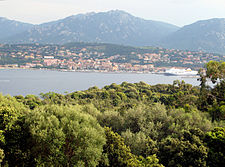 Corsica's coastline is a major driver for tourism – coastline by the town of Propriano
Corsica's coastline is a major driver for tourism – coastline by the town of Propriano
Corsica is the least economically developed region in Metropolitan France.[1] Tourism plays a big part in the Corsican economy. The island's climate, mountains and coastlines make it popular among tourists. The island has not had the same level of intensive development as other parts of the Mediterranean and is thus mainly unspoiled. Tourism is particularly concentrated in the area around Porto Vecchio and Bonifacio in the south of the island and Calvi in the northwest.
In 1584 the Genoese governor ordered all farmers and landowners to plant four trees yearly; a chestnut, olive, fig and mulberry tree. Many communities owe their origin and former richness to the ensuing chestnut woods.[11] Chestnut bread keeps fresh for as long as three weeks.[12] Corsica produces gourmet cheese, wine, sausages, and honey for sale in mainland France and for export. Corsican honey, of which there are six official varietals, is certified as to its origin (Appellation d'origine contrôlée) by the French National Institute of Origin and Quality (Institut National des Appellations d'Origine – INAO).
Transport
Railway
Corsica has 232 kilometres (144 mi) of narrow-gauge railway. The main line runs between Bastia and Ajaccio and there is a branch line from Ponte-Leccia to Calvi. The trains are operated by Chemins de fer de Corse (CFC).
There is also a third line along the east coast that is no longer in use due to heavy damage during World War II. There has been talk of restoring it but as yet nothing has happened.
Politics
Corsica is currently governed in almost the same way as any other région of France. There are several nationalist movements on the island calling for some degree of Corsican autonomy from France or even full independence. Generally speaking, autonomist proposals focus on the promotion of the Corsican language, more power for local governments, and some exemptions from national taxes in addition to those already applying to Corsica.
The French government is opposed to full independence but has at times shown support for some level of autonomy. There is support on the island for proposals of greater autonomy, but polls show that a large majority of Corsicans are opposed to full independence.[13]
In 1972, the Italian company Montedison dumped toxic waste off the Corsican coast, creating what looked like red mud in waters around the island with the poisoning of the sea, the most visible effects being cetaceans found dead on the shores.
At that time the Corsican people felt that the French government did not support them since it did not complain to Italy to make this situation change. To stop the poisoning, one ship carrying toxic waste from Italy was bombed.
Organisations started to seek money, acting like the Mafia, to fund violence. Some groups that claim to support Corsican independence, such as the National Liberation Front of Corsica, have carried out a violent campaign since the 1970s that includes bombings and assassination, usually targeting buildings and officials representing the French government or Corsicans themselves for political reasons. A war between two rival independence groups led to several deaths in the 1990s. The peaceful occupation of a pied-noir vineyard in Aléria in 1975 marked a turning point when the French government responded with overwhelming force, generating sympathy for the independence groups among the Corsican population.
In 2000, Prime Minister Lionel Jospin agreed to grant increased autonomy to Corsica. The proposed autonomy for Corsica would have included greater protection for the Corsican language (Corsu), the island's traditional language (similar to Italian), whose practice and teaching, like other regional or minority languages in France, had in the past been discouraged. According to the UNESCO classification, the Corsican language is currently in danger of becoming extinct. However, plans for increased autonomy were opposed by the Gaullist opposition in the French National Assembly, who feared that they would lead to calls for autonomy from other régions (such as Brittany, Alsace, or Provence), eventually threatening France's unity as a country.
In a referendum on 6 July 2003, a narrow majority of Corsican voters opposed a project from the government of Jean-Pierre Raffarin and then-Interior Minister Nicolas Sarkozy that would have suppressed the two départements of the island and granted greater autonomy to the territorial collectivity of Corsica.[citation needed]
See also
- Corsica et Sardinia
- Corsica national football team
- Corsica Nazione
- Corsica wine
- P&M Corsican Whisky
- Corsican immigration to Puerto Rico
- Corsican immigration to Venezuela
- Corsican Italians
- Corsican language
Notes
- ^ a b c "GDP per inhabitant in 2006 ranged from 25% of the EU27 average in Nord-Est in Romania to 336% in Inner London". Eurostat. http://epp.eurostat.ec.europa.eu/pls/portal/docs/PAGE/PGP_PRD_CAT_PREREL/PGE_CAT_PREREL_YEAR_2009/PGE_CAT_PREREL_YEAR_2009_MONTH_02/1-19022009-EN-AP.PDF.
- ^ "Wanderings in Corsica: its history and its heroes". Ferdinand Gregorovius (1855). p.196.
- ^ Jacques Massu obituary
- ^ a b Price, Gillian. Walking on Corsica: Long-Distance and Short Walks. Cicerone Press Limited. p. 9. ISBN 1-85284-387-x.
- ^ Keyser, William (2005). "Corsican Villages and Towns" (PDF). Corsica Isula. http://www.corsica-isula.com/downloads/Corsican_Villages_and_Towns.pdf. Retrieved 29 April 2008.
- ^ "Climatological Information for Ajaccio, France" – Hong Kong Observatory
- ^ Gregory, Desmond (1985). The ungovernable rock: a history of the Anglo-Corsican Kingdom and its role in Britain's Mediterranean strategy during the Revolutionary War, 1793–1797. London: Fairleigh Dickinson University Press. p. 16. ISBN 0838632254.
- ^ C. Michael Hogan. 2009. Hooded Crow: Corvus cornix, GlobalTwitcher.com, ed, N. Stromberg
- ^ MacPhee, R.D.E.; Hans-Dieter Sues (1999). Extinctions in Near Time: Causes, Contexts, and Consequences. Springer. p. 179. ISBN 0306460920.
- ^ 2004 statistics:Atlas des populations immigrées en Corse. (French)
- ^ The Chestnut Tree in terracorsa.
- ^ The Grocer's Encyclopedia – Encyclopedia of Foods and Beverages. By Artemas Ward. New York. 1911.
- ^ "89 % des corses opposés à l’indépendance de l’île" (in French), Nouvel Observateur, http://tempsreel.nouvelobs.com/actualite/politique/20081001.OBS3635/89-des-corses-opposes-a-l-independance-de-l-ile.html.
Bibliography
- Loughlin, John. 1989. "Regionalism and Ethnic Nationalism in France: A Case-study of Corsica". Thesis. San Domenico, Italy: European University Institute.
- Loughlin, John, and Claude Olivesi (eds.). 1999. Autonomies insulaires: vers une politique de différence pour la Corse. Ajaccio: Editions Albiana. ISBN 2905124474
- Saul, John Ralston. 1992. Voltaire's Bastards: The Dictatorship of Reason in the West. New York: Free Press; Maxwell Macmillan International. ISBN 0029277256
External links
- Costa, L.J.; Cécile Costa (2005). "Préhistoire de la Corse". Kyrnos Publications pour l'archéologie. http://www.prehistoire-corse.org/. Retrieved 26 April 2008. (French)
- "TerraCorsa,I Muvrini and much more Corsican music". TerraCorsa. http://www.terracorsa.info. Retrieved 22 august 2011.
- Dumas, Alexandre (1845, 2003). "The Corsican Brothers". Arthur's Classical Novels. Archived from the original on 19 April 2008. http://web.archive.org/web/20080419073755/http://arthursclassicnovels.com/arthurs/dumas/corsic10.html. Retrieved 27 April 2008. (English)
- Corsica at the Open Directory Project (English)
- "Corsica". Wikitravel. 2008. http://wikitravel.org/en/Corsica. Retrieved 26 April 2008.
- "National Geographic Magazine: Corsica Map". National Geographic Society. 2003. http://yellowbordermagazine.com/ngm/0304/feature3/map.html. Retrieved 5 May 2008.
- "Corsica rejects autonomy offer by Paris". CNN. 6 July 2003. Archived from the original on 8 April 2008. http://web.archive.org/web/20080408111248/http://www.cnn.com/2003/WORLD/europe/07/06/corsica.poll/index.html. Retrieved 26 April 2008.
- Keyser, Will. "Corsica from the inside!". Corsica Isula. http://www.corsica-isula.com. Retrieved 26 April 2008.
- jabro. "Getting around in Corsica by bicycle". jabro.net. http://www.jabro.net/photos-fotky/by-bicycle/category/2-korsika-corsica-corse. Retrieved 28 August 2009.
- Guiderdoni, jf. "A different visit of Corsica". corsica_experience. http://www.corsicaexperience.com. Retrieved 5 June 2011.
- Lohninger, Hans (2004). "PhotoGlobe: Photos – Corsica". http://www.photoglobe.info/db_corsica/index.html. Retrieved 26 April 2008.
Regions of France - Alsace
- Aquitaine
- Auvergne
- Burgundy
- Brittany
- Centre
- Champagne-Ardenne
- Corsica
- Franche-Comté
- Île-de-France
- Languedoc-Roussillon
- Limousin
- Lorraine
- Midi-Pyrénées
- Nord-Pas-de-Calais
- Lower Normandy
- Upper Normandy
- Pays de la Loire
- Picardy
- Poitou-Charentes
- Provence-Alpes-Côte d'Azur
- Rhône-Alpes
- Overseas regions:
- French Guiana
- Guadeloupe
- Martinique
- Mayotte
- Réunion
Coordinates: 42°9′N 9°5′E / 42.15°N 9.083°E

 Historical Provinces of France
Historical Provinces of FranceProvinces Alsace • Angoumois • Anjou • Artois • Aunis • Auvergne • Basse-Navarre • Béarn • Beaujolais • Berry • Bourbonnais • Brittany • Burgundy • Champagne • Corsica • Dauphiné • Flanders and Hainaut • Foix • Forez • Franche-Comté • Gascony • Guyenne • Île-de-France • Languedoc • Limousin • Lorraine • Lyonnais • Maine • Marche • Montbéliard • Mulhouse • Nice • Nivernais • Normandy • Orléanais • Perche • Picardy • Poitou • Provence • Roussillon • Saintonge • Savoy • Touraine • Trois-Évêchés • Venaissin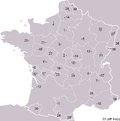 Categories:
Categories:- Former provinces of France
- Corsica
- Regions of France
- Mediterranean islands
- Territories of the Republic of Genoa
Wikimedia Foundation. 2010.

